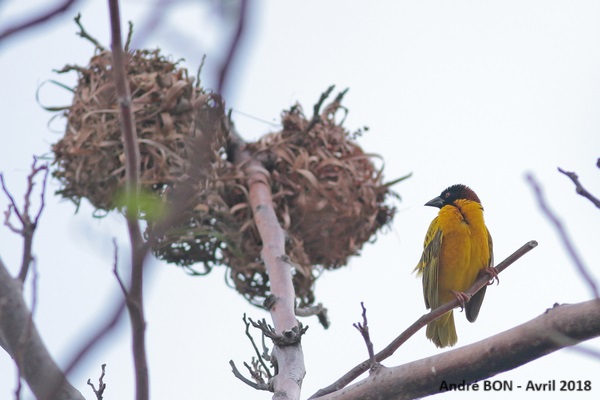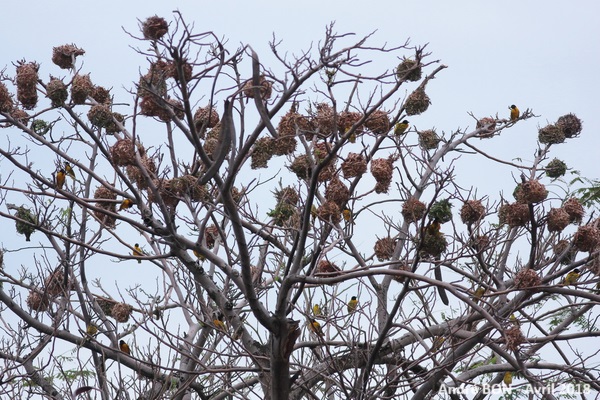



| Village Weaver (Ploceus cucullatus (Statius Müller, 1776)) |




|
|
Scientific name: Ploceus cucullatus (Statius Müller, 1776) Common name: Village Weaver Other names: Spotted-backed Weaver, Black-headed Weaver. French name: Tisserin gendarme, Serin du Cap. Order: Passeriformes Family: Ploceidae Size: Body size: 15 to 18 cm; Weight: 32 to 45 g; Wingspan: 20 to 38 cm. Habitat: Savannah with large trees, forest edges and clearings, wetlands and also parks and gardens in villages and urban areas. Missing in very arid areas and dense forests. Food: Village Weavers feed in groups on the ground, on seeds and various invertebrates. Nesting: The ball-shaped nest is built by the male with long plant fibres. It hangs at the end of a high branch. The nests are grouped in colonies and there can be 20 to 60 nests on a large tree. The entrance to the nest is located in the lower part and provides access to the main chamber lined with small leaves. There is a clutch of 2 to 4 eggs usually between June and February. Migration: Sedentary. Geographic area: Sub-Saharan Africa, except desert areas of Botswana and Namibia. There are seven subspecies: Ploceus cucullatus cucullatus (main subspecies): Mauritania east to Chad and south across West Africa to Bioko, northern Gabon and northwest of the Democratic Republic of Congo, Ploceus cucullatus graueri: from eastern Democratic Republic of Congo to Rwanda, Burundi and adjacent western Tanzania, Ploceus cucullatus bohndorffi: northern Gabon, Central African Republic, northern Democratic Republic of Congo, southwest South Sudan, Uganda, western Kenya and northwest Tanzania, Ploceus cucullatus frobenii: southern Democratic Republic of Congo, Ploceus cucullatus abyssinicus: Eritrea, Ethiopia, south-eastern Sudan and eastern South Sudan, Ploceus cucullatus collaris: from Gabon to the southwest of the Democratic Republic of Congo and northern Angola, Ploceus cucullatus spilonotus or Ploceus cucullatus dilutescens: from south-eastern Botswana to southern Mozambique, South Africa and Lesotho. Introduced in the Dominican Republic, Haiti, Puerto Rico, Martinique, Venezuela (main subspecies cucullatus), Mauritius and Reunion Island (subspecies spilonotus from southern Africa). |
Village Weavers show strong sexual dimorphism in breeding plumage. The subspecies differ mainly in the head patterns of the males. I will limit myself to the description of the main subspecies. Males of the type subspecies, Ploceus cucullatus cucullatus, have a black head with a small black tip extending across the top of the throat. The nape is chestnut and this colour extends on each side under the black of the head. The bill is strong and black, the eye is red. The back is black and yellow. The wings and tail are olive green with yellow edges. The lower parts are yellow and can be more or less coloured depending on the individual, up to orange-brown. The legs are pink. Females have paler and less contrasting plumage, yellow, olive brown, whitish yellow. The bill is light grey. Males of the southern African subspecies, Ploceus cucullatus spilonotus have yellow tops of their heads. |
| [To know more about the Village Weaver] [Next picture] [Top] |

|
Here is a typical male of the Ploceus cucullatus cucullatus subspecies in breeding plumage. We were passing through the small village of Le Prêcheur when my attention was drawn to a tree with many nests. |
| [To know more about the Village Weaver] [Next picture] [Previous picture] [Top] |

|
Here is a nest under construction, it is the work of the males. |
| [To know more about the Village Weaver] [Next picture] [Previous picture] [Top] |

|
All my shots suffer from a low angle view but it's difficult to do otherwise when the scenes take place at the top of a large tree. Afterwards I realized that I only took photos of males. I just found here one more reason to go swimming once again in Martinique (and I'm not talking about my stock of good rum which has dropped significantly...) |
| [To know more about the Village Weaver] [Previous picture] [Top] |

|
Here is a view of the top of the tree, you see more than 60 nests. |